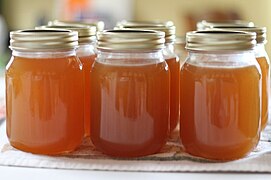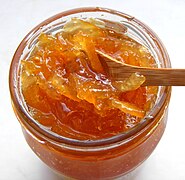Any of various sweetened foods in Korean cuisine
Cheong (청; 淸) is a name for various sweetened foods in the form of syrups, marmalades, and fruit preserves. In Korean cuisine, cheong is used as a tea base, as a honey-or-sugar-substitute in cooking, as a condiment, and also as an alternative medicine to treat the common cold and other minor illnesses.[1][2][3]
Originally, the word cheong (청; 淸) was used to refer to honey in Korean royal court cuisine.[4] The name jocheong (조청; 造淸; "crafted honey") was given to mullyeot (liquid-form yeot) and other human-made honey-substitutes.[5][6] Outside the royal court, honey has been called kkul (꿀), which is the native (non-Sino-Korean) word.[citation needed]
Varieties
Maesil-cheong
Maesil-cheong (매실청; 梅實淸, [mɛ.ɕil.tɕʰʌŋ]), also called "plum syrup", is an anti-microbial[medical citation needed] syrup made by sugaring ripe plums (Prunus mume). In Korean cuisine, maesil-cheong is used as a condiment and sugar substitute. The infusion made by mixing water with maesil-cheong is called maesil-cha (plum tea).
It can be made by simply mixing plums and sugar together, and then leaving them for about 100 days.[7] To make syrup, the ratio of sugar to plum should be at least 1:1 to prevent fermentation, by which the liquid may turn into maesil-ju (plum wine).[8] The plums can be removed after 100 days, and the syrup can be consumed right away, or mature for a year or more.[7]
Mogwa-cheong
Mogwa-cheong (모과청 [mo.ɡwa.tɕʰʌŋ]), also called "preserved quince", is a cheong made by sugaring Chinese quince (Pseudocydonia sinensis). Either sugar or honey can be used to make mogwa-cheong.[9] Mogwa-cheong is used as a tea base for mogwa-cha (quince tea) and mogwa-hwachae (quince punch), or as an ingredient in sauces and salad dressings.[10][11]
Yuja-cheong
Yuja-cheong (유자청; 柚子淸, [ju.dʑa.tɕʰʌŋ]), also called "yuja marmalade", is a marmalade-like cheong made by sugaring peeled, depulped, and thinly sliced yuja (Citrus junos). It is used as a tea base for yuja-cha (yuja tea), as a honey-or-sugar-substitute in cooking, and as a condiment.[12][13][14]








